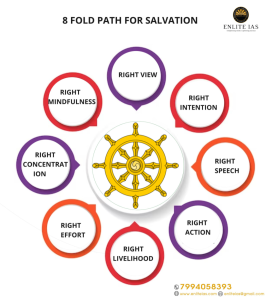Buddhism: Philosophy
- Founded by Siddhartha Gautama (Buddha) in the 6th century BCE in Northern India
Gautama Buddha
|
Four Noble Truths
- There is Suffering (Dukha)
- There is a Cause for the suffering (Samudaya)
- Suffering can be ended (Nirodha)
- There is a path to end the suffering (Ashtangika-Marga)
Eight fold path to Salvation
- Right View
- Right Intention
- Right Speech
- Right Action
- Right Livelihood
- Right Effort
- Right Concentration
- Right Mindfulness

Important Aspects of Buddhism
- Law of Dependent Origination – It explains the cause of suffering and way to escape from suffering to attain nirvana
- No Soul Theory – Buddha is silent on the metaphysical aspects rather he asked laymen to focus on the empirical life.
- Theory of Momentariness – Everything exists for a moment hence everything is impermanent.
- Stand on Varna System – Buddhism was against the Varna system, hence most of the followers were from the merchant class, Kshatriyas, and other classes of people.
Schools of Buddhism
Hinayana /Theravada(Lesser Vehicle) School
- Theravada Buddhism is the earliest to uphold Buddha’s original vision and teachings.
- Believed in Individual liberation.
- Theravada, or the School of the Elders, emerged in approximately 250 BCE through Buddha’s earliest pupils.
- The Vipassana (mindfulness) movement is a current school of thought within Theravada Buddhism.
- Hinayana focuses on Buddha’s fundamental teachings, the four noble truths, and the eightfold path.
- They live a strict monastic life of meditation to achieve nirvana.
- They do not worship Buddha as a divinity, but rather follow his karma and meditation teachings.
Mahayana School
- Revered Buddha, hence idol worship was prominent.
- Bodhisattvas to aid the mass liberation process.
- They obtained salvation by praising Buddha and following his main teachings.
- More inclusive than Hinayana School
Vajrayana Buddhism
- Followed tantric practices which were usually not preferred in other accepted religions.
- A majority of Vajrayana Buddhism’s symbols and rites are centred on the pursuit of enlightenment.
- According to Vajrayana Buddhism, it can shorten the road to enlightenment by lowering the number of incarnations required before reaching insight.
